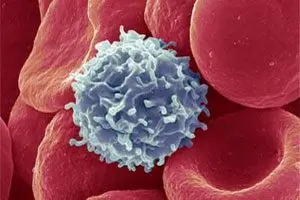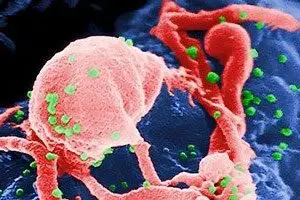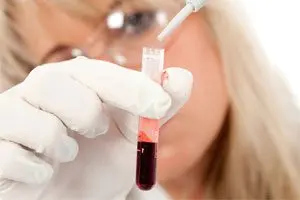Contents

Lymphocytosis is an increase in the level of lymphocytes in the blood above 37%. Lymphocytes are blood cells from the group of leukocytes. They perform the most important function in the body – they provide the immune defense of a person. Therefore, an increase in their number is an alarming signal that may indicate pathological processes.
The thymus (before the onset of puberty) and the bone marrow are responsible for the formation of lymphocytes. In these organs, cells divide and simply exist. Also, a person has secondary lymphoid organs – these are lymph nodes, spleen and formations in the gastrointestinal tract. They contain the vast majority of lymphocytes. In the spleen, these cells are stored and die.
Depending on the type of cells, lymphocytes perform the following functions in the body:
They produce immunoglobulins, which are designed to protect a person from pathogens. This is done by B-lymphocytes. They guarantee long-term or even lifelong immunity to various diseases.
T-lymphocytes are involved in the elimination of viruses and parasites. They are responsible for the strength of the body’s immune response in response to an infection.
NK-lymphocytes destroy cancer cells.
Indicators of the norm of lymphocytes will vary depending on the age of the person. Absolute values of lymphocytes:
Newborns and infants: 0,8-9*109 cells/litre.
Older children: 0,8-8*109 cells/litre.
Adults, regardless of gender: 0,8-4 * 109 cells/litre.
Relative values of lymphocytes:
Newborns: 15-35%.
Under the age of one year: 45-70%.
Older children: 30-50%.
Adults: 30-40%.
In connection with the available data, there are relative and absolute lymphocytosis. Absolute lymphocytosis is indicated when the number of lymphocytes exceeds age norms. Therefore, they speak of lymphocytosis in an adult when the level of lymphocytes exceeds 4 * 109 cells per litre.
Relative lymphocytosis is indicated if there is a numerical preponderance of lymphocytes. This can happen when the level of neutrophils increases. The absolute values of lymphocytes may remain within the normal range. In this case, doctors talk about leukopenia with neutropenia.
If the level of neutrophils is reduced, and the level of lymphocytes is increased in percentage terms, then it is not always possible to make a correct diagnosis. Therefore, doctors are more interested in the absolute indicator of their level.
Causes of lymphocytosis

The causes of lymphocytosis can be as follows:
Stressful conditions, jumps in the level of hormones in the body. In addition, exercise and menstrual bleeding in a woman can cause an increase in the level of lymphocytes. Such lymphocytosis is temporary and resolves on its own.
Tobacco smoking for many years. If a person suffers from this addiction, then the level of lymphocytes in him can remain stably high. In parallel, erythrocytosis is observed.
Infectious diseases with damage to the body by viruses, bacteria or parasites. In this case, the immune system is quickly activated. If the infection is bacterial in nature, then the level of neutrophils in the blood increases, and with a viral infection, the number of lymphocytes increases. Therefore, any viral infection is accompanied by lymphocytosis. This indicates the activation of the body’s defenses and its active resistance to the disease. The elevated lymphocyte count will persist until recovery occurs. Mononucleosis, whooping cough, tuberculosis, syphilis, and some other chronic bacterial infections can lead to lymphocytosis.
Blood cancer: chronic lymphocytic leukemia and acute lymphoblastic leukemia. When the bone marrow is damaged, immature lymphoblasts are formed in it, which do not have the opportunity to become full-fledged lymphocytes. These cells are not able to form normal immunity, so the person begins to suffer from various infections. And he will be sick for a long time. Acute lymphoblastic leukemia most often develops in childhood, but is less common in adults. In chronic lymphocytic leukemia, the number of mature lymphocytes in the bone marrow increases, but they are unable to perform their functions.
thyrotoxicosis. Lymphocytes take part in the immune reactions of the body, proceeding according to a delayed type. Therefore, an increase in their number in the blood may indicate autoimmune processes. Thyrotoxicosis is one of the clearest examples of such a disorder. In addition, other autoimmune processes can be accompanied by lymphocytosis: Crohn’s disease, rheumatoid arthritis, etc.
Intoxication of the body with lead, arsenic or carbon disulfide. In case of poisoning, relative lymphocytosis is observed, at this time it is important to monitor the level of neutrophils in order to prevent a sharp drop in immunity.
The passage of therapy with a number of drugs. Lymphocytosis can be caused by taking such drugs as: Levomycetin, Levodopa, Phenytoin, Valproic acid, some analgesics.
Splenectomy. Removal of the spleen is an operation that can be performed in a hospital only for certain indications. Its absence in the body can provoke a temporary increase in the level of lymphocytes in the blood. Then the internal systems adapt and blood counts will return to normal.
Symptoms of lymphocytosis

Lymphocytosis is not an independent pathology, but only a consequence of any disorders or changes in the body. Therefore, the symptoms of an increase in the level of lymphocytes in the blood will be determined by the symptoms of the underlying disease.
With viral infections, fever, sore throat, intestinal disorders, skin rashes, etc. come to the fore. In addition to lymphocytosis, the patient will also have other abnormalities in blood counts.
With tumors of the hematopoietic tissue, patients develop bone pain, the body temperature will remain elevated all the time. Bleeding increases, immunity decreases.
With lymphocytosis and neutropenia, there is a high probability of a viral infection, such as whooping cough, SARS, diphtheria, sepsis, etc. With lymphocytosis and monocytopenia, it makes sense to suspect measles, chickenpox, mumps. If monocytes and lymphocytes are significantly higher than normal, then the patient should be checked for monocytic leukemia or myelodysplastic syndrome.
With infectious mononucleosis, the patient has an increase in body temperature, a sore throat appears, lymph nodes increase in size, weakness and sweating increase, especially at night. The disease is caused by the Epstein-Barr virus.
Serious poisoning and bacterial infections contribute to an increase in the absolute and relative levels of lymphocytes. In this case, the jump can be quite impressive.
Chronic lymphocytosis, which persists in a person for a long time period, may be a sign of a sluggish infection, immunodeficiency, or a developing cancer. As a rule, the immunity of such patients is reduced, they get sick for a long time and often, suffer from constant weakness. Body temperature can remain at the level of subfebrile values.
At the same time, a long-term slight increase in the level of lymphocytes in healthy people is possible. Experts do not exclude that this may be due to the individual characteristics of the body.
Lymphocytosis in a child

After the birth of the child, he will have increased levels of neutrophils in the blood. By about the 10th day of life, the level of lymphocytes begins to grow, their percentage is about 60% of all blood cells. A similar picture will be observed up to 5-7 years. In the future, the values of lymphocytes will return to normal and approach those in an adult. Therefore, lymphocytosis in a young child is a variant of the norm and is not any pathological sign.
Most often, the child’s body reacts to any infection with a significant jump in the level of lymphocytes. Moreover, other blood cells will remain within normal limits. The cause of leukocytosis can be chickenpox, measles, mononucleosis, influenza, rubella and other infectious diseases. After their elimination, the level of lymphocytes will return to its age norm. If this does not happen, or lymphocytosis persists for a long time, it makes sense to undergo a comprehensive examination.
How to diagnose lymphocytosis?

To diagnose lymphocytosis in a person, it is necessary to pass a clinical blood test. In past years, laboratory assistants performed all calculations manually, examining a blood smear under a microscope. Modern laboratories are equipped with automated devices that perform this work. Therefore, the indicators of lymphocytes may vary in the same person, depending on how exactly they were counted.
If the doctor has any doubts, then he can prescribe another blood test with the calculation of the absolute value of lymphocytes. Existing deviations from the norm are compared with specific symptoms that bother the patient. Additional examinations are ordered as needed.
Treatment of lymphocytosis

There is no treatment for lymphocytosis, as this condition is not an independent disease. Therapy is determined by the cause that provoked an increase in the level of lymphocytes in the blood.
In acute infections, antiviral drugs or antibiotics are prescribed. You may need antifungals. For a speedy recovery, you need to drink as much liquid as possible, in parallel, symptomatic treatment is carried out, aimed at lowering body temperature, eliminating pain, removing intoxication, etc.
If a malignant tumor is detected, the patient is prescribed cytostatics, immunosuppressants. To prevent complications, the patient is prescribed fungicides and antibiotics.
To prevent the development of lymphocytosis, it is necessary to direct efforts to strengthen the immune system, lead a healthy lifestyle, eat right, temper. During periods of outbreaks of viral infections, crowded places should be avoided, hands should be washed with soap, and vitamin and mineral complexes should be taken.
Lymphocytosis is not a cause for panic. Most likely, after getting rid of the disease, lymphocytes will return to normal on their own. In any case, with the appearance of inexplicable weakness, with prolonged low-grade fever and other pathological symptoms, you should consult a doctor and undergo a comprehensive examination. The sooner treatment is prescribed, the higher the chances of a speedy recovery.









